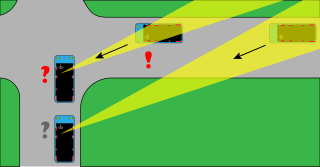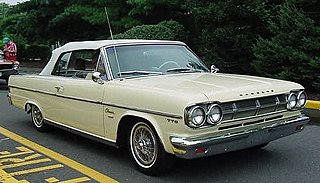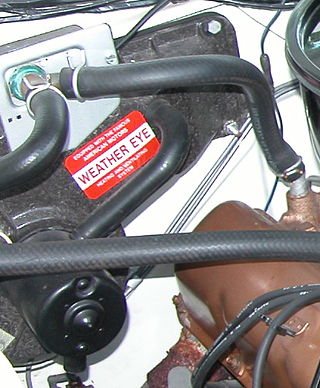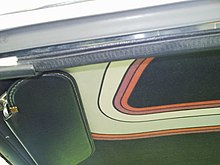
The AMC Pacer is a two-door compact car produced in the United States by American Motors Corporation (AMC) from the 1975 through the 1980 model years. The Pacer was also made in Mexico by Vehículos Automotores Mexicanos (VAM) from 1976 until 1979 and positioned as a premium-priced luxury car.

The AMC Javelin is an American front-engine, rear-wheel-drive, two-door hardtop automobile manufactured by American Motors Corporation (AMC) across two generations, 1968 through 1970 and 1971 through 1974 model years. The car was positioned and marketed in the pony car market segment.

A blind spot in a vehicle or vehicle blind spot is an area around the vehicle that cannot be directly seen by the driver while at the controls, under existing circumstances. In transport, driver visibility is the maximum distance at which the driver of a vehicle can see and identify prominent objects around the vehicle. Visibility is primarily determined by weather conditions and by a vehicle's design. The parts of a vehicle that influence visibility include the windshield, the dashboard and the pillars. Good driver visibility is essential to safe road traffic.

A visor is a surface that protects the eyes, such as shading them from the sun or other bright light or protecting them from objects.

A steering wheel is a type of steering control in vehicles.

The Ambassador is an automobile manufactured and marketed by American Motors Corporation (AMC) from 1957 through 1974 over eight generations, available in two- and four-door sedan, two-door hardtop, four-door station wagon as well as two-door convertible body styles. It was classified as a full-size car from 1957 through 1961, mid-size from 1962 until 1966, and again full-size from 1967 through 1974 model years.

A sunroof is a movable panel that opens to uncover a window in an automobile roof, allowing light and fresh air to enter the passenger compartment. Sunroofs can be manually operated or motor driven, and are available in many shapes, sizes and styles. While the term "sunroof" is now used generically to describe any glass panel in the roof, the term "moonroof" was historically used to describe stationary glass panes rigidly mounted in the roof panel over the passenger compartment. A moonroof has a glass panel that is transparent and usually tinted. Previous terms include Sunshine Roof, Sliding Head and Sliding Roof.

The AMC Hornet is a compact automobile manufactured and marketed by American Motors Corporation (AMC) and made from 1970 through 1977 — in two- and four-door sedan, station wagon, and hatchback coupe configurations. The Hornet replaced the compact Rambler American line, marking the end of the Rambler marque in the American and Canadian markets.

The Scotsman is an automobile series that was produced by the Studebaker Packard Corporation of South Bend, Indiana, during model years 1957 and 1958, and a low-priced series of pickup trucks in 1958 and 1959. The name was based on the reputation of Scottish frugality, the cars being built for function and minimalism.

A rear-view mirror is a flat mirror in automobiles and other vehicles, designed to allow the driver to see rearward through the vehicle's rear window.

The Oldsmobile Vista Cruiser is a station wagon manufactured and marketed by Oldsmobile over three generations from 1964 to 1977.

The pillars on a car with permanent roof body style are the vertical or nearly vertical supports of its window area or greenhouse—designated respectively as the A, B, C and D-pillar, moving from front to rear, in profile view.

The AMC Rebel is a midsized car produced by American Motors Corporation (AMC) from the 1967 until the 1970 model year. It replaced the Rambler Classic. The Rebel was replaced by the similar AMC Matador for the 1971 model year. The Rebel was positioned as the high-volume seller in the independent automaker's line of models.

The Rambler Classic is an intermediate sized automobile that was built and sold by American Motors Corporation (AMC) from the 1961 through 1966 model years. The Classic took the place of the Rambler Six and Rambler Rebel V-8 names, which were retired at the end of the 1960 model year.

The Rambler Rebel is an automobile that was produced by the American Motors Corporation (AMC) of Kenosha, Wisconsin for the 1957–1960 model years, as well as again for 1966 and 1967.

The Rambler Marlin is a two-door fastback automobile produced in the United States by American Motors Corporation from 1965 to 1967. A halo car for the company, it was marketed as a personal luxury car.

The Weather Eye was a trade name for a Nash Motors-designed fresh-air system for automobile passenger compartment heating, cooling, and ventilating. The Nash "All-Weather Eye" was the first automobile air conditioning system for the mass market. The use of the Weather Eye name for automobile passenger heating and air conditioning systems continued in American Motors Corporation (AMC) vehicles.

The Rambler Six and the Rambler V8 are intermediate sized automobiles that were built and marketed by American Motors Corporation (AMC) from 1956 to 1960.

The Blakely Bernardi is an automobile produced in the 1980s by Blakely Auto Works of Princeton, Wisconsin, USA. Blakely produced a number of automobile models, including the Bearcat and Bantam. This model is named after Enrico Bernardi, Italian inventor of the gasoline internal-combustion engine and automobile pioneer. The Bernardi was available as a completed car or as a kit of parts to be assembled by the buyer.

The first generation of the Ford F-Series is a series of trucks that was produced by Ford from the 1948 to the 1952 model years. The introduction of the F-Series marked the divergence of Ford car and truck design, developing a chassis intended specifically for truck use. Alongside pickup trucks, the model line included also panel vans, bare and cowled chassis, and marked the entry of Ford into the medium and heavy-duty truck segment.





















